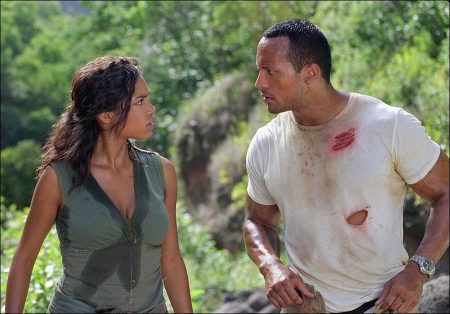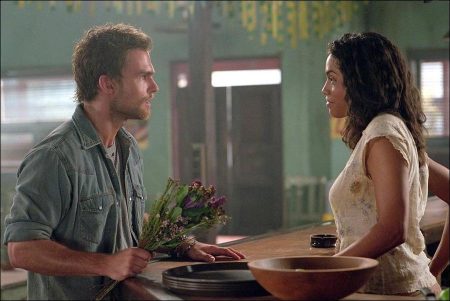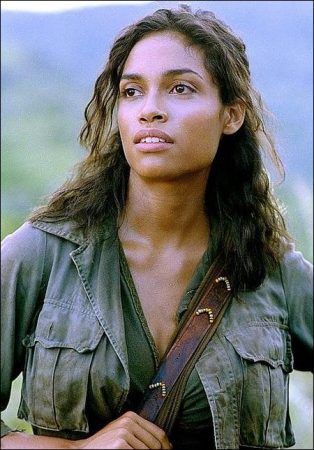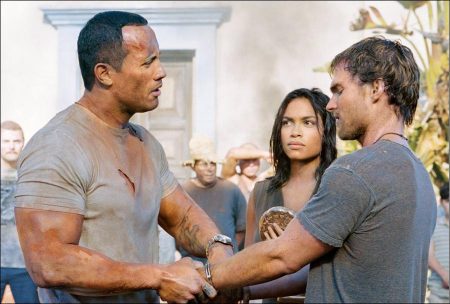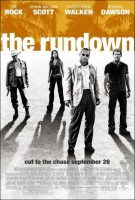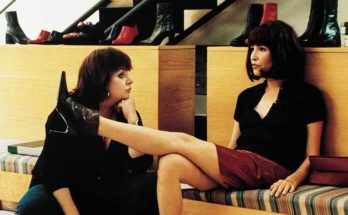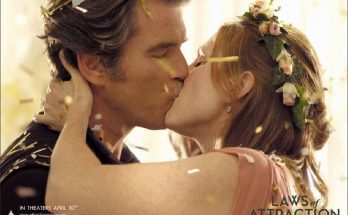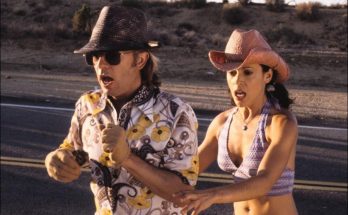Taglines: Bulls, guns, whips, gold and one sacred cat.
The Rundown movie storyline. Beck (The Rock) doesn’t look for or try to make trouble for anyone. But trouble is what he’s hired to clean up, and there’s one final mess he’s got to get out of before he can leave it all behind. And this one just keeps getting more and more tangled, like the Amazon jungle he’s been sent to in The Rundown.
At the center of his current trouble is a wise-ass named Travis (Scott), a fast-talking double dealer whose dad has commissioned Beck to retrieve from a lingering adventure in Brazil. Travis proves to be more of a handful than Beck expected, not only because of his mouth and his heels-dug-in reluctance to leave, but because of a couple of other complications he brings with him: Mariana (Rosario Dawson), a no-nonsense local who holds the answers to some of the jungle’s hidden mysteries, and Hatcher (Walken), an unhinged despot who has turned the jungle and its inhabitants into his own fortune-making, gold-mining empire.
Beck doesn’t like to fight. But he’s going to have to unleash everything he’s got to keep on top of his smack-talking quarry, the girl with the secret, the crazy tyrant, the horny monkeys, the hallucinogenic fruit, the backs-to-the-wall rebels, the perilous terrain, the hidden traps and every other obstacle that this jungle throws at him.
About the Production
Essential to crafting a believable character who has an aversion to guns and relies more on hand-to-hand combat, the filmmakers and The Rock agreed that they needed someone who understood the visual aspects of a fight as much as the physical and could translate that into evocative and original fight sequences. Andy Cheng, a fight choreographer who worked with The Rock on The Scorpion King, fit the bill on all counts.
Director Berg observes, “Andy Cheng did a wonderful job of taking what was a Hong Kong-influenced style of fighting and reinventing it. He took the acrobatics of the style and customized it to the Brazilian jungle setting. What comes across is a believable combat style for these guerilla-style rebels. So now, in some ways, it’s like he invented a new style of fighting.”
The Rock explains, “Andy Cheng has a modern approach to designing fights that incorporates everything—strength, speed and agility—that people can relate to. He always wants to make things different which, in turn, makes Andy very unique.”
Adds Misher, “Andy has the eye on how to put action on the screen, without equal. He’s the guy who knows how to do something that people haven’t seen before and puts a fresh spin even if you think you have.”
Cheng, who also serves as a second unit director (with additional second unit direction from E.J. Foerster) worked closely with Peter Berg to inject creative (and sometime humorous) elements into the picture’s plentiful action. Both The Rock and Scott were very focused as they prepared for their physically demanding roles. The resulting transformations are evident in both of their leaner physiques, particularly for The Rock, who shed close to 40 pounds for the role.
The Rock wasn’t the only one the filmmakers were looking at to deliver some of the film’s eye-popping action. To their delight, they found in Scott an actor ready, willing and able to delve into the more physical aspects of the role. Scott had recently completed shooting Bulletproof Monk, a film that required five months of aerial wirework training and conditioning, so he too was geared up for what Cheng was envisioning.
“I love being physical,” explains Scott of the film’s action. “I like the action that I get to do. It’s not like I’m The Terminator or Rambo. Travis is the guy who’s not going to give up. He’s not a great fighter but he’s always bouncing back. It works really well with what Rock is doing.”
Extensive stunt rehearsals beginning in pre-production prepared The Rock and Scott for what the filmmakers had in store for them. Over the course of filming they both were strung upside-down from a 50-foot tree for a scene that filmed over several days; Scott dove from an exploding bus; and The Rock, strapped into aerial wires, was hurled more than 30 feet through the air.
The final climactic fight sequence, which takes place in and ravages the town of El Dorado, was particularly arduous for the actors. An elaborately choreographed sequence replete with fights, explosions, and hundreds of squibs detonating around the actors had them running, jumping and diving for cover—all quite safely, of course.
The jungle locale figured prominently into the script and although set in the Brazilian Amazon, the filmmakers thought the lush, vibrant beauty of Hawaii’s own rainforests—complete with towering Banyan trees, spectacular waterfalls and other breathtaking locales—offered a multitude of options for the film’s exotic setting.
Brazil was briefly considered for some of the film’s secondary locales, but a scouting trip to research design ideas for production designer Tom Duffield reinforced the decision to film entirely in the U.S. when Berg, Misher, Duffield, executive producer Ric Kidney and their escorts had an unexpected and frightening encounter with armed bandits outside the city of Manaus. (While the local guides pleaded for everyone’s safe release, the assailants relieved the group of their cash and camera equipment. Everyone safely returned stateside but in a unique example of art imitating life, the filmmakers felt compelled to utilize parts of their encounter for The Rundown, infusing the film’s dialogue, as well as costume and production design, with the experience.)
Before filming commenced on the Hawaiian island of Oahu, a kahu, a Hawaiian priest, presided over a traditional blessing, courtesy of The Rock, a former resident of the island, and the filmmakers. Five weeks of filming expansive jungle exterior scenes followed before the company returned to Los Angeles. Other locations used for filming included Hollywood, Hancock Park, the tropical garden of the Los Angeles Arboretum (which provided backdrop for the rebel campsite) and soundstages in Van Nuys, which housed several sets (including the ingeniously designed underwater cavern and tunnel which lead to the entombed Gato Diablo and the Amazones Bar where Mariana works).
Perhaps most notable, though, is the unique set for the village of El Dorado. Located 15 miles north of Los Angeles in the foothills of the San Gabriel Mountains, the enormous set was constructed within a four-acre parcel of land, which also included a work area for the crew and a holding pen for hundreds of animals.
Working closely with the U.S. Fish and Wildlife Service and a number of state and city agencies, the filmmakers commissioned a detailed environmental impact study, as well as ornithological and ichthyological surveys of the area, to ensure that production’s presence did not have any permanent ecological affects before they broke ground on the film set.
Production designer Duffield and his department designed, constructed and landscaped the village, which gave the filmmakers an inordinate amount of creative and technical options for filming. Duffield and his team (working with greens coordinator Danny Ondrejko) brought in hundreds of pounds of red dirt and thousands of tropical plants to lay the foundation for the enormous set.
What followed were over two months of labor-intensive construction of 50 structures that make up El Dorado—including a church, markets, bars, restaurants, homes and Hatcher’s two-storey concrete observation deck, flanked by 500-foot hills of molded dirt (fashioned from red-tinted wood and plaster) that border the gaping gold mine.
The jungle setting was completed with large-scale landscaping of coconut, palm and banana trees, ferns and other tropical plants—all supported by their own irrigation system.
“We literally created a tropical rainforest in the desert,” points out Duffield of the maintenance for the site.
With a discerning level of detail, set decorator Gary Fettis accented the town with every sort of embellishment—from markets overflowing with Brazilian candy, posters, magazines, cigarettes and canned food to several rusted-out early model automobiles sitting on cinder blocks. Brazilian background artists filming on the sets were amazed to recognize hometown brands placed throughout the sprawling set. The Rock, commenting on the detail that went into constructing the village, says, “What’s amazing to me is that you can literally be dropped right in the middle of this set with your eyes closed, only to open them and think you’re in a small South American town. The art department did an incredible job.”
In addition to looking authentic, however, the set also had to withstand the rigors of two film units filming the large-scale action movie, sometimes simultaneously. At times a visit to the set found horses, cattle, pigs, chickens, hundreds of background players, explosions, buildings shredded by gunfire, and dozens of fires burning—all simultaneously—while cast and crew executed their jobs in various areas of the set.
El Dorado handled the punishment of filming well, but the true test for the makeshift town was several days of unexpected high winds courtesy of Mother Nature. The film crew was plagued with fierce dust storms of red dirt that made it difficult to see (let alone film). Tin-roofed structures and tropical plants sustained minor damage but as a testament to its sturdy construction, all was easily repaired.
Nevertheless, when filming concluded, Duffield and his crew began returning the area to its original condition, beginning with the demolition and removal of the structures, dirt and plants. Once completed, the process continued with a re-grading of the entire area to its original topography and re-vegetating the surrounding area, followed by several months of monitoring the area as it settled back to pre-Rundown “normal.”
The Rundown (2003)
Directed by: Peter Berg
Starring: Dwayne Johnson, Seann William Scott, Christopher Walken, Rosario Dawson, William Lucking, Ewen Bremner, Jon Gries, Stuart F. Wilson, Dennis Keiffer, Toby Holguin
Screenplay by: James Vanderbilt, Kario Salem
Production Design by: Tom Duffield
Cinematography by: Tobias A. Schliessler
Film Editing by: Richard Pearson
Costume Design by: Louise Mingenbach
Set Decoration by: Gary Fettis
Music by: Harry Gregson-Williams
MPAA Rating: PG-13 for adventure violence, some crude dialogue.
Distributed by: Universal Pictures (North America), Columbia Pictures (International)
Release Date: September 26, 2003
Views: 66
